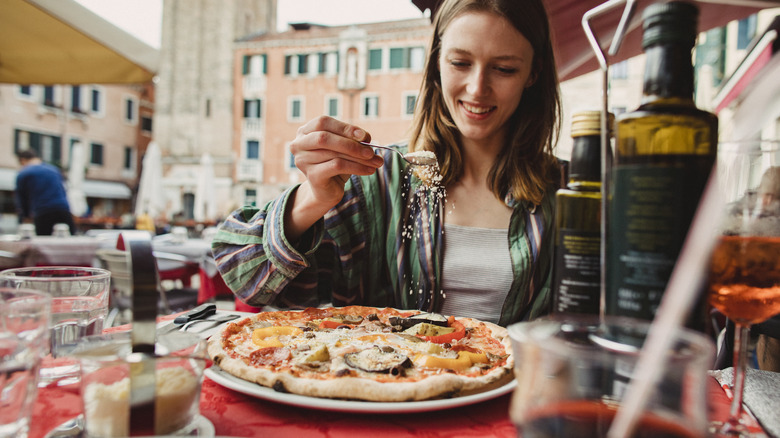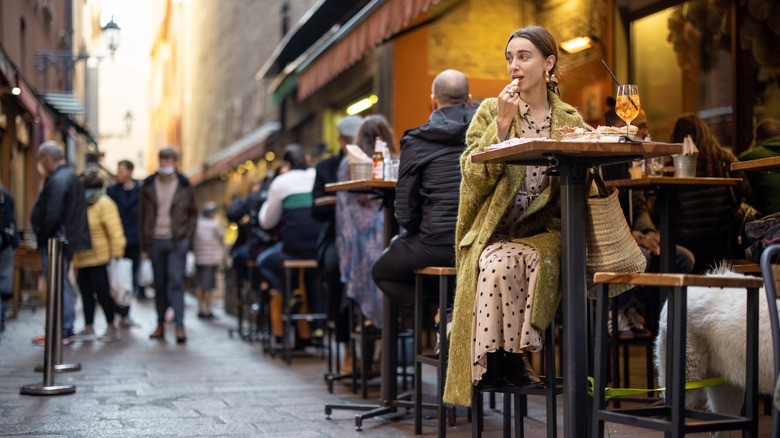Check An Italian Restaurant's Menu For This Unexpected Signal That It's A Tourist Trap
With its rich history, stunning architecture, and vibrant culture, Italy is a traveler's dream destination. Throw in mountains of pasta, fresh seafood, and the tastiest gelato of your dreams and you've basically got a recipe for perfection. However, not all food is made equal in Italy — much like not all Italian restaurants are made the same. So, while some stick to tradition and use fresh, local ingredients, others tend to go a little too heavy on the tourist-chasing — which ultimately dilutes the authenticity.
Thankfully, TikTok user and Italy travel consultant Jenna Chaplin, also known as @italy.with.jenna, has the inside scoop to make sure you don't fall for any common tourist traps while traveling to Italy. From laminated, picture-heavy menus and restaurants that stay open all day, to spots with multiple waiters trying to convince you to grab a bite there, knowing how to pinpoint the most obvious red flags can make the difference between enjoying an authentic meal and wasting your money on an underwhelming experience by eating like a tourist in Italy.
The classic signs of a tourist trap in Italy
Breaking things down, Chaplin highlights exactly what you need to watch out for — and avoid — if you want to have an authentic Italian meal. According to her video, one of the most telltale signs is having laminated menus. Why's that? Well, a set, laminated menu that stays the same year-round doesn't take into account one of Italy's most important elements when it comes to good food: seasonality. Meaning that, since ingredients like asparagus are typically harvested in the spring, you shouldn't find them anywhere on the menu at the height of summer. The same goes for, say, radicchio. As a popular winter vegetable, it shouldn't make an appearance before then.
Another sign you should be wary of is English-written menus that read more like a picture book, with a never-ending number of pages, dishes, and photos plastered all over. Per Chaplin's video, having so many dishes on offer means that the restaurant needs to be constantly stocked up on tons of food, which then suggests that the quality and freshness of the ingredients are probably compromised.
Lastly, according to Chaplin, another massive red flag is when there are multiple waitstaff trying to coerce you into eating at the restaurant — especially when it's "out of hours" for locals to be eating there. That said, as a rule of thumb, most restaurants that stay open past "Italian lunchtime" (between noon and 3 p.m.) or before dinner (8 p.m.) should be approached with caution.
What to look for instead
The key to a great dining experience in Italy is all about paying attention to the details — specifically, the location and ambiance of a restaurant. With that in mind, one of the most important things to do when choosing a place to eat is to move away from the tourist hotspots. Walk down the more quiet alleyways to hit up the unassuming hole-in-the-wall spots that feel genuine from the get-go.
Ideally, you'll want to choose places with a small menu — printed on one side is best, with minimal to no English translations — posted outside with no "hype-man" trying to convince you to sit down. Not only will this ensure a more authentic dining experience, but it'll also enhance your connection to the local culture, all of which sets the scene like something out of "Eat, Pray, Love." If you want to take it a step further — like, a big step — make sure the table doesn't have any salt or pepper shakers, either. In line with Italian culture, the chef has already seasoned the food to perfection, so why would you (aka, not an expert) want to ruin that?
Alternatively, if you're not really up for the hunt, you can also let someone else do the choosing by signing up for a local food tour — there's one in Rome that's hailed as one of the best-rated experiences in Europe — that'll take you to all of the tastiest spots. Buon appetito!

